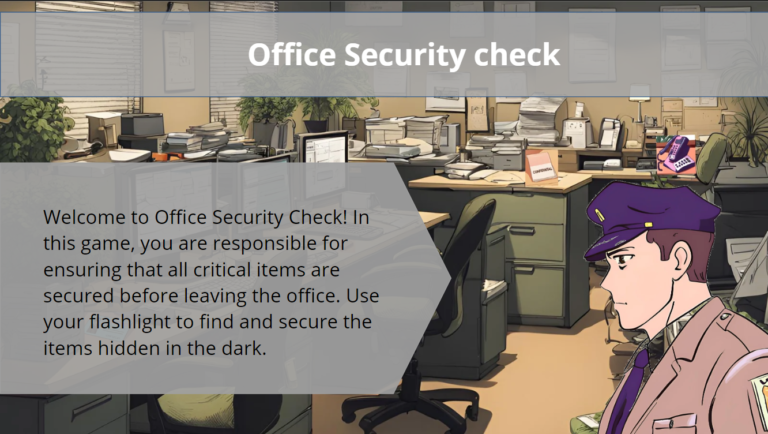


April 2024
For My Portfolio
Storyline 360




Enhancing Security Awareness and Practices for Office Personnel.
In the “Office Security Check” simulation, users take on the role of security personnel conducting routine inspections after office hours. This simulation serves dual purposes: to equip security personnel with the skills to identify security vulnerabilities, and to educate office staff on proper security practices and the importance of adherence to protocols.
This simulation caters to security personnel responsible for after-hours security checks and office staff seeking to understand security protocols. Both audiences benefit from practical insights into maintaining a secure office environment.
01# Perform thorough security checks after office hours. # Identify and rectify security vulnerabilities such as misplaced confidential documents, unattended access keycards, unauthorized USB drives, and mishandled desk phones.
02# Action Mapping (Tool Used: MindMeister) # Text-based Storyboard (Tool Used: Microsoft Word) # Visual Mockups (Tool Used: Canva) # Interactive Prototype (Tool Used: Storyline 360)
03Organizations often face challenges in maintaining security standards outside of regular business hours. Incidents like unauthorized access or data breaches due to mishandled sensitive information can compromise organizational security.
To address these challenges, I developed an interactive simulation where users utilize a virtual torch to conduct office security inspections. The simulation prompts users to identify and address security issues including misplaced sensitive documents, unsecured access cards, unauthorized USB drives, and desk phones that have been improperly handled.
I started by mapping out essential actions required for effective office security checks using MindMeister. This facilitated prioritization and structured the simulation’s development process.
I created a detailed storyboard in Microsoft Word, outlining scenario-based interactions and decision points users would encounter during the simulation. This provided a narrative framework for realistic security scenarios.
Using Canva, I developed visual mockups depicting the office environment under dim lighting conditions, focusing on realism and user immersion. These mockups guided visual design and ensured consistency in user interface elements.
In Storyline 360, I built an interactive prototype allowing users to navigate the simulated office environment using a virtual torch. Upon identifying security vulnerabilities, users interacted with pop-up messages explaining the significance of each finding and its potential implications.
The “Office Security Check” simulation successfully provided a realistic training experience for both security personnel and office staff. Feedback highlighted increased awareness of security protocols and improved readiness to address potential security breaches.